Protective Properties of Silane Composite Coatings Modified with Poly(3,4-ethylenedioxythiophene) with Heteropolyacid on X20Cr13 and 41Cr4 Steel
Abstract
1. Introduction
2. Materials and Methods
2.1. Materials
2.2. Coating Preparation
2.3. Characteristics of Coatings
3. Results and Discussion
3.1. Scotch Test
3.2. Thickness of the Coatings
3.3. Analysis of 2D Surface Geometry: Roughness Parameter
3.4. Analysis of Coating Composition
- Absorbance bands observed at values of 3061 cm−1, 2959 cm−1, and 1275 cm−1 correspond to the asymmetric stretching and bending vibrations of the C-H bond belonging to the -Si-(OCH3) group;
- Further peaks were recorded at 1604 cm−1 and 1408 cm−1, which correspond to stretching vibrations of the C=C bond of the CH2=CH-group;
- 1002 cm−1, 885 cm−1, and 742 cm−1 bands correspond to Si-O-C vibration;
- A broad band observed at 1190–1000 cm−1 corresponds to asymmetric stretching vibrations of Si-O-Si bonds;
- A peak at 692 cm−1 corresponds to the Si-C bond;
- A peak at 927 cm−1 was attributed to asymmetric bending vibrations of the Si-OH bond;
- 1021 cm−1, 953 cm−1, 852 cm−1, and 805 cm−1—four characteristic bands of the PMo12 ion, which can be related to asymmetric stretching with edge oxygen, respectively: P-O, Mo=O, Mo-Oc-Mo, and Mo-Oe-Mo;
- 583 cm−1: the band attributed to the Keggin δ (O-P-O) structure;
- 529 cm−1 and 414 cm−1: sharp Si-O bond bands.
3.5. Corrosion Testing
- X20Cr13 by approximately 0.9 V compared to uncoated steel (VTMS/PEDOT/PMo12 coating with 0.25 g of EDOT/PMo12 powder);
- 41Cr4 by approximately 0.7 V compared to uncoated steel (VTMS/PEDOT/PMo12 coating with 0.25 g of EDOT/PMo12 powder).
- 50 to 100 h for VTMS/PEDOT/PMo12 coating with 0.1 g of EDOT/PMo12 powder for X20Cr13 and 41Cr4 steels;
- 120 to 125 h for VTMS/PEDOT/PMo12 coating with 0.15 g of EDOT/PMo12 powder for X20Cr13 steel;
- 125 to 160 h for VTMS/PEDOT/PMo12 coating with 0.15 g of EDOT/PMo12 powder for 41Cr4 steel.
4. Conclusions
Author Contributions
Funding
Institutional Review Board Statement
Informed Consent Statement
Data Availability Statement
Conflicts of Interest
References
- Cobb, H.M. The History of Stainless Steel; ASM International: Northeast Ohio, OH, USA, 2010. [Google Scholar]
- Rossi, B. Discussion on the use of stainless steel in constructions in view of sustainability. Thin-Walled Struct. 2014, 83, 182–189. [Google Scholar] [CrossRef]
- Gardner, L. Stability and design of stainless steel structures–Review and outlook. Thin-Walled Struct. 2019, 141, 208–216. [Google Scholar] [CrossRef]
- Gardner, L. The use of stainless steel in structures. Prog. Struct. Eng. Mater. 2005, 7, 45–55. [Google Scholar] [CrossRef]
- Dutta, S. Different types and new applications of stainless steel. Stainl. Steel 2018, 62, 86–91. [Google Scholar]
- McGuire, M.F. Stainless Steels for Design Engineers; ASM International: Northeast Ohio, OH, USA, 2008. [Google Scholar]
- Birtărescu, E.; Nedeloni, M.D.; Pedrali, P.C.; Câmpian, C.V.; Nedeloni, L.; Ene, T.; Bogdan, S.L. Some laboratory tests regarding the X20Cr13 martensitic stainless steel behaviour. In IOP Conference Series: Materials Science and Engineering; IOP Publishing: Bristol, UK, 2018; Volume 416, p. 012025. [Google Scholar]
- Dewidar, M.M.; Khalil, K.A.; Lim, J.K. Processing and mechanical properties of porous 316L stainless steel for biomedical applications. Trans. Nonferrous Met. Soc. China 2007, 17, 468–473. [Google Scholar] [CrossRef]
- Kostadin, T.; Jakovljevic, S. Analysis of corrosion resistance when turning martensitic stainless steel X20Cr13 under chilled air-cooling. Adv. Prod. Eng. Manag. 2017, 12, 105–114. [Google Scholar] [CrossRef][Green Version]
- Ryan, M.P.; Williams, D.E.; Chater, R.J.; Hutton, B.M.; McPhail, D.S. Why stainless steel corrodes. Nature 2002, 415, 770–774. [Google Scholar] [CrossRef]
- Kadry, S. Corrosion analysis of stainless steel. Eur. J. Sci. Res. 2008, 22, 508–516. [Google Scholar]
- Xavier, J.R. Investigation on the anticorrosion, adhesion and mechanical performance of epoxy nanocomposite coatings containing epoxy-silane treated nano-MoO3 on mild steel. J. Adhes. Sci. Technol. 2020, 34, 115–134. [Google Scholar] [CrossRef]
- Wang, L.; Liu, C.S.; Yu, H.Y.; An, C.Q. Structure and corrosion resistance of a composite γ-amino propyl triethoxy silane and γ-glycidoxy propyl trimethoxy silane conversion coating on galvanized steel. J. Iron Steel Res. Int. 2012, 19, 46–51. [Google Scholar] [CrossRef]
- Fedel, M.; Olivier, M.; Poelman, M.; Deflorian, F.; Rossi, S.; Druart, M.E. Corrosion protection properties of silane pre-treated powder coated galvanized steel. Prog. Org. Coat. 2009, 66, 118–128. [Google Scholar] [CrossRef]
- Pape, P.G. Adhesion promoters: Silane coupling agents. In Applied Plastics Engineering Handbook; William Andrew Publishing: Norwich, NY, USA, 2011; pp. 503–517. [Google Scholar]
- Walker, P. Silane and other adhesion promoters in adhesive technology. Handb. Adhes. Technol. N. Y. Taylor Fr. Group 2003, 205–222. [Google Scholar]
- Matisons, J.G. Silane coupling agents and glass fibre surfaces: A perspective. Silanes Other Coupling Agents 2009, 5, 3–22. [Google Scholar]
- Mittal, K.L. Silanes and Other Coupling Agents; CRC Press: Leiden, The Netherlands; Boston, MA, USA, 2007; Volume 4. [Google Scholar]
- Lung, C.Y.K.; Matinlinna, J.P. Aspects of silane coupling agents and surface conditioning in dentistry: An overview. Dent. Mater. 2012, 28, 467–477. [Google Scholar] [CrossRef] [PubMed]
- Lo, T.N.; Lee, J.; Hwang, H.S.; Park, I. Nanoscale coatings derived from fluoroalkyl and PDMS alkoxysilanes on rough aluminium surfaces for improved durability and anti-icing properties. ACS Appl. Nano Mater. 2021, 4, 7493–7501. [Google Scholar] [CrossRef]
- Tshabalala, M.A.; Kingshott, P.; VanLandingham, M.R.; Plackett, D. Surface chemistry and moisture sorption properties of wood coated with multifunctional alkoxysilanes by sol-gel process. J. Appl. Polym. Sci. 2003, 88, 2828–2841. [Google Scholar] [CrossRef]
- Romero-Gavilán, F.; Carlos-Almeida, J.; Cerqueira, A.; Gurruchaga, M.; Goni, I.; Miranda-Salvado, I.M.; Suay, J. Sol-gel coatings made using methyl-modified alkoxysilanes: The balance between protection and bioactivation. Prog. Org. Coat. 2020, 147, 105770. [Google Scholar] [CrossRef]
- Wang, S.; Mahlberg, R.; Jämsä, S.; Nikkola, J.; Mannila, J.; Ritschkoff, A.C.; Peltonen, J. Surface properties and moisture behaviour of pine and heat-treated spruce modified with alkoxysilanes by sol–gel process. Prog. Org. Coat. 2011, 71, 274–282. [Google Scholar] [CrossRef]
- Yaneff, P.V.; Adamsons, K.; Ryntz, R.A.; Britz, D. Structure/property relationships in flexible alkoxysilane automotive coatings. J. Coat. Technol. 2002, 74, 135–141. [Google Scholar] [CrossRef]
- Sardon, H.; Irusta, L.; González, A.; Fernández-Berridi, M.J. Waterborne hybrid polyurethane coatings functionalized with (3-aminopropyl) triethoxysilane: Adhesion properties. Prog. Org. Coat. 2013, 76, 1230–1235. [Google Scholar] [CrossRef]
- Jang, J.; Kim, E.K. Corrosion protection of epoxy-coated steel using different silane coupling agents. J. Appl. Polym. Sci. 1999, 71, 585–593. [Google Scholar] [CrossRef]
- Plueddemann, E.P. Reminiscing on silane coupling agents. J. Adhes. Sci. Technol. 1991, 5, 261–277. [Google Scholar] [CrossRef]
- Boerio, F.J.; Edwin, P. Plueddemann: Experimental laboratory chemist. J. Adhes. Sci. Technol. 1991, 5, 253–260. [Google Scholar] [CrossRef]
- Blum, F.D.; Meesiri, W.; Kang, H.J.; Gambogi, J.E. Hydrolysis, adsorption, and dynamics of silane coupling agents on silica surfaces. J. Adhes. Sci. Technol. 1991, 5, 479–496. [Google Scholar] [CrossRef]
- Ahmad, N.; MacDiarmid, A.G. Inhibition of corrosion of steels with the exploitation of conducting polymers. Synth. Met. 1996, 78, 103–110. [Google Scholar] [CrossRef]
- Racicot, R.; Clark, R.L.; Liu, H.B.; Yang, S.C.; Alias, M.N.; Brown, R. Thin film conductive polymers on aluminum surfaces: Interfacial charge-transfer and anticorrosion aspects. In Optical and Photonic Applications of Electroactive and Conducting Polymers; SPIE’s 1995 International Symposiumon Optical Science, Engineering and Instrumentation; SPIE: San Diego, CA, USA, 1995; Volume 2528, pp. 251–258. [Google Scholar]
- Tallman, D.E.; Pae, Y.; Bierwagen, G.P. Conducting polymers and corrosion: Polyaniline on steel. Corrosion 1999, 55, 779–786. [Google Scholar] [CrossRef]
- Zarras, P.; Anderson, N.; Webber, C.; Irvin, D.J.; Irvin, J.A.; Guenthner, A.; Stenger-Smith, J.D. Progress in using conductive polymers as corrosion-inhibiting coatings. Radiat. Phys. Chem. 2003, 68, 387–394. [Google Scholar] [CrossRef]
- Zubair, N.A.; Rahman, N.A.; Lim, H.N.; Sulaiman, Y. Production of conductive PEDOT-coated PVA-GO composite nanofibers. Nanoscale Res. Lett. 2017, 12, 113. [Google Scholar] [CrossRef]
- Ohtsuka, T. Corrosion protection of steels by conducting polymer coating. Int. J. Corros. 2012, 1, 915090. [Google Scholar] [CrossRef]
- Adamczyk, A. Polimery przewodzące w ochronie przed korozją. Ochr. Przed Korozją 2018, 12, 363–368. [Google Scholar] [CrossRef]
- Luo, S.C.; Yu, H.H.; Wan, A.C.; Han, Y.; Ying, J.Y. A General Synthesis for PEDOT-Coated Nonconductive Materials and PEDOT Hollow Particles by Aqueous Chemical Polymerization. Small 2008, 4, 2051–2058. [Google Scholar] [CrossRef] [PubMed]
- Kumar, A.M.; Hussein, M.A.; Adesina, A.Y.; Ramakrishna, S.; Al-Aqeeli, N. Influence of surface treatment on PEDOT coatings: Surface and electrochemical corrosion aspects of newly developed Ti alloy. RSC Adv. 2018, 8, 19181–19195. [Google Scholar] [CrossRef] [PubMed]
- Vreeland, R.F.; Atcherley, C.W.; Russell, W.S.; Xie, J.Y.; Lu, D.; Laude, N.D.; Heien, M.L. Biocompatible PEDOT: Nafion composite electrode coatings for selective detection of neurotransmitters in vivo. Anal. Chem. 2015, 87, 2600–2607. [Google Scholar] [CrossRef]
- Rohwerder, M. Conducting polymers for corrosion protection: A review. Int. J. Mater. Res. 2009, 100, 1331–1342. [Google Scholar] [CrossRef]
- Bazli, L.; Yusuf, M.; Farahani, A.; Kiamarzi, M.; Seyedhosseini, Z.; Nezhadmansari, M.; Iranpoor, M. Application of composite conducting polymers for improving the corrosion behavior of various substrates: A Review. J. Compos. Compd. 2020, 2, 228–240. [Google Scholar] [CrossRef]
- Adamczyk, L.; Dudek, A. The Influence of Components Concentration in the Electrodeposition Process on the Protective Properties of 3,4-ethylenedioxythiophene (EDOT) with 4-(pyrrole-1-yl) Benzoil Acid (PYBA), Polyoxyethylene-10-laurylethier (BRIJ) and Lithium Perchlorate; EU: Brno, Czech Republic, 2019. [Google Scholar]
- Zhu, D.; Lu, X.; Lu, Q. Electrically conductive PEDOT coating with self-healing superhydrophobicity. Langmuir 2014, 30, 4671–4677. [Google Scholar] [CrossRef]
- Boehler, C.; Aqrawe, Z.; Asplund, M. Applications of PEDOT in bioelectronic medicine. Bioelectron. Med. 2019, 2, 89–99. [Google Scholar] [CrossRef]
- Zhang, Z.; Tian, G.; Duan, X.; Chen, H.L.; Kim Richie, D.H. Nanostructured PEDOT Coatings for Electrode–Neuron Integration. ACS Appl. Bio Mater. 2021, 4, 5556–5565. [Google Scholar] [CrossRef]
- Heydari Gharahcheshmeh, M.; Wan, C.T.C.; Ashraf Gandomi, Y.; Greco, K.V.; Forner-Cuenca, A.; Chiang, Y.M.; Gleason, K.K. Ultrathin conformal oCVD PEDOT coatings on carbon electrodes enable improved performance of redox flow batteries. Adv. Mater. Interfaces 2020, 7, 2000855. [Google Scholar] [CrossRef]
- Gueye, M.N.; Carella, A.; Faure-Vincent, J.; Demadrille, R.; Simonato, J.P. Progress in understanding structure and transport properties of PEDOT-based materials: A critical review. Prog. Mater. Sci. 2020, 108, 100616. [Google Scholar] [CrossRef]
- Namsheer, K.; Rout, C.S. Conducting polymers: A comprehensive review on recent advances in synthesis, properties and applications. RSC Adv. 2021, 11, 5659–5697. [Google Scholar]
- Schultze, J.W.; Karabulut, H. Application potential of conducting polymers. Electrochim. Acta 2005, 50, 1739–1745. [Google Scholar] [CrossRef]
- Wang, X.S.; Tang, H.P.; Li, X.D.; Hua, X. Investigations on the mechanical properties of conducting polymer coating-substrate structures and their influencing factors. Int. J. Mol. Sci. 2009, 10, 5257–5284. [Google Scholar] [CrossRef] [PubMed]
- Riaz, U.; Nwaoha, C.; Ashraf, S.M.; Laboratory, M.R. Recent advances in corrosion protective composite coatings based on conducting polymers and natural resource derived polymers. Prog. Org. Coat. 2014, 77, 743–756. [Google Scholar] [CrossRef]
- Guimard, N.K.; Gomez, N.; Schmidt, C.E. Conducting polymers in biomedical engineering. Prog. Polym. Sci. 2007, 32, 876–921. [Google Scholar] [CrossRef]
- Kowalski, D.; Ueda, M.; Ohtsuka, T. Self-healing ion-permselective conducting polymer coating. J. Mater. Chem. 2010, 20, 7630–7633. [Google Scholar] [CrossRef]
- McFarlane, S.L.; Deore, B.A.; Svenda, N.; Freund, M.S. A one-step, organic-solvent processable synthesis of PEDOT thin films via in situ metastable chemical polymerization. Macromolecules 2010, 43, 10241–10245. [Google Scholar] [CrossRef]
- Ouyang, L.; Kuo, C.C.; Farrell, B.; Pathak, S.; Wei, B.; Qu, J.; Martin, D.C. Poly [3,4-ethylene dioxythiophene (EDOT)-co-1,3,5-tri [2-(3,4-ethylene dioxythienyl)]-benzene (EPh)] copolymers (PEDOT-co-EPh): Optical, electrochemical and mechanical properties. J. Mater. Chem. B 2015, 3, 5010–5020. [Google Scholar] [CrossRef]
- Wei, B.; Liu, J.; Ouyang, L.; Kuo, C.C.; Martin, D.C. Significant enhancement of PEDOT thin film adhesion to inorganic solid substrates with EDOT-acid. ACS Appl. Mater. Interfaces 2015, 7, 15388–15394. [Google Scholar] [CrossRef]
- Zuber, K.; Fabretto, M.; Hall, C.; Murphy, P. Improved PEDOT conductivity via suppression of crystallite formation in Fe (III) tosylate during vapor phase polymerization. Macromol. Rapid Commun. 2008, 29, 1503–1508. [Google Scholar] [CrossRef]
- Kucharczyk, A.; Adamczyk, L. Wpływ dodatku polimeru przewodzącego (PEDOT, PANI) na właściwości ochronne powłok antykorozyjnych na bazie silanu (VTMS) i surfaktantu (BRIJ) osadzonych na stali X20Cr13. Poszerzamy Horyzonty 2022, 32, 203–210. [Google Scholar]
- Karnicka, K.; Chojak, M.; Miecznikowski, K.; Skunik, M.; Baranowska, B.; Kolary, A.; Kulesza, P.J. Polyoxometallates as inorganic templates for electrocatalytic network films of ultra-thin conducting polymers and platinum nanoparticles. Bioelectrochemistry 2005, 66, 79–87. [Google Scholar] [CrossRef] [PubMed]
- Adamczyk, L.; Kulesza, P.J.; Miecznikowski, K.; Palys, B.; Chojak, M.; Krawczyk, D. Effective charge transport in poly (3,4-ethylenedioxythiophene) based hybrid films containing polyoxometallate redox centers. J. Electrochem. Soc. 2005, 152, E98. [Google Scholar] [CrossRef]
- Szymanska, D.; Rutkowska, I.A.; Adamczyk, L.; Zoladek, S.; Kulesza, P.J. Effective charge propagation and storage in hybrid films of tungsten oxide and poly (3, 4-ethylenedioxythiophene). J. Solid State Electrochem. 2010, 14, 2049–2056. [Google Scholar] [CrossRef]
- Adamczyk, L. Development of copper-stabilized conducting-polymer/polyoxometalate hybrid materials for effective electrochemical charging. J. Solid State Electrochem. 2017, 21, 211–222. [Google Scholar] [CrossRef]
- Adamczyk, L.; Kulesza, P.J. Fabrication of composite coatings of 4-(pyrrole-1-yl) benzoate-modified poly-3,4-ethylenedioxythiophene with phosphomolybdate and their application in corrosion protection. Electrochim. Acta 2011, 56, 3649–3655. [Google Scholar] [CrossRef]
- de Oliveira, A.d.N.; Barbosa de Lima, M.A.; de Oliveira Pires, L.H.; Rosas da Silva, M.; Souza da Luz, P.T.; Angélica, R.S.; da Rocha Filho, G.N.; da Costa, C.E.F.; Luque, R.; Santos do Nascimento, L.A. Bentonites Modified with Phosphomolybdic Heteropolyacid (HPMo) for Biowaste to Biofuel Production. Materials 2019, 12, 1431. [Google Scholar] [CrossRef]
- da Silva, M.J.; de Oliveira, C.M. Catalysis by Keggin heteropolyacid salts. Curr. Catal. 2018, 7, 26–34. [Google Scholar] [CrossRef]
- Adamczyk, L.M.; Kulesza, P.J. Preparation and Protective Properties of Composite Films of Poly (3,4-etylenedioxythiophene) with Seteropolyanions on Stainless Steel. ECS Trans. 2008, 13, 85. [Google Scholar] [CrossRef]
- Kaoua, R.; Bennamane, N.; Bakhta, S.; Benadji, S.; Rabia, C.; Nedjar-Kolli, B. Synthesis of Substituted 1,4-Diazepines and 1,5-Benzodiazepines Using an Efficient Heteropolyacid-Catalyzed Procedure. Molecules 2011, 16, 92–99. [Google Scholar] [CrossRef]
- Adamczyk, L.; Miecznikowski, K. Solid-state electrochemical behavior of Keggin-type borotungstic acid single crystal. J. Solid State Electrochem. 2013, 17, 1167–1173. [Google Scholar] [CrossRef][Green Version]
- Song, I.K.; Barteau, M.A. Redox properties of Keggin-type heteropolyacid (HPA) catalysts: Effect of counter-cation, heteroatom, and polyatom substitution. J. Mol. Catal. A Chem. 2004, 212, 229–236. [Google Scholar] [CrossRef]
- Han, D.S.; Hwang, T. An adaptive pre-distorter for the compensation of HPA nonlinearity. IEEE Trans. Broadcast. 2000, 46, 152–157. [Google Scholar]
- Song, I.K.; Barteau, M.A. Scanning tunneling microscopy (STM) and tunneling spectroscopy (TS) of heteropolyacid (HPA) self-assembled monolayers (SAMS): Connecting nano properties to bulk properties. Korean J. Chem. Eng. 2002, 19, 567–573. [Google Scholar] [CrossRef]
- Park, D.R.; Park, S.; Bang, Y.; Song, I.K. Redox properties and oxidation catalysis of group 5 metal (V, Nb, Ta)-containing Keggin and Wells–Dawson heteropolyacid (HPA) catalysts. Appl. Catal. A Gen. 2010, 373, 201–207. [Google Scholar] [CrossRef]
- Bidan, G.; Genies, E.M.; Lapkowski, M. Polypyrrole and poly (N-methylpyrrole) films doped with Keggin-type heteropolyanions: Preparation and properties. J. Electroanal. Chem. Interfacial Electrochem. 1988, 251, 297–306. [Google Scholar] [CrossRef]
- Saenko, E.; Sarafanov, A.; Ananyeva, N.; Behre, E.; Shima, M.; Schwinn, H.; Josić, D. Comparison of the properties of phospholipid surfaces formed on HPA and L1 biosensor chips for the binding of the coagulation factor VIII. J. Chromatogr. A 2001, 921, 49–56. [Google Scholar] [CrossRef]
- White, A.M.; Slade, R.C. Electrochemically and vapour grown electrode coatings of poly (3,4-ethylenedioxythiophene) doped with heteropolyacids. Electrochim. Acta 2004, 49, 861–865. [Google Scholar] [CrossRef]
- Adekoya, G.J.; Sadiku, R.E.; Ray, S.S. Nanocomposites of PEDOT: PSS with graphene and its derivatives for flexible electronic applications: A review. Macromol. Mater. Eng. 2021, 306, 2000716. [Google Scholar] [CrossRef]
- McDonald, M.B.; Freund, M.S. Novel conducting polymer-heteropoly acid hybrid material for artificial photosynthetic membranes. ACS Appl. Mater. Interfaces 2011, 3, 1003–1008. [Google Scholar] [CrossRef]
- Góral, M.; Jouini, M.; Perruchot, C.; Miecznikowski, K.; Rutkowska, I.A.; Kulesza, P.J. Integration of vanadium-mixed addenda Dawson heteropolytungstate within poly (3,4-ethylenedioxythiophene) and poly (2,2′-bithiophene) films by electrodeposition from the nonionic micellar aqueous medium. Electrochim. Acta 2011, 56, 3605–3615. [Google Scholar] [CrossRef]
- Badea, G.E.; Fodor, A.; Petrehele, A.I.G.; Maior, I.; Toderaș, M.; Morgovan, C.M. Evaluation of phosphopolyoxometalates with mixed Addenda (Mo, W, V) as corrosion inhibitors for steels. Materials 2023, 16, 7600. [Google Scholar] [CrossRef] [PubMed]
- Wang, X.F.; Liu, X.Y.; Su, F.; Li, J.S.; Zhu, Z.M.; Sang, X.J.; Zhang, L.C. Enhanced corrosion resistance of carbon steel in hydrochloric acid solution by Polyoxometalate-Estertin derivatives. ACS Omega 2022, 7, 4429–4443. [Google Scholar] [CrossRef] [PubMed]
- Romaric Wamba Tchio, O.; Pengou, M.; Baumier, C.; Franger, S.; Teillout, A.L.; Martyr Mbomekallé, I.; Ngameni, E. Comparison between Lacunary and Saturated Keggin Polyoxometalates as Steel Corrosion Inhibitors in Chloride Solution: Contribution of the Lacuna in the Inhibition Mechanism. ChemistrySelect 2020, 5, 10135–10143. [Google Scholar] [CrossRef]
- Standard Test Methods for Measuring Adhesion by Tape Test. Available online: https://www.galvanizeit.com/uploads/resources/ASTM-D-3359-yr-2010.pdf (accessed on 12 December 2024).
- Kucharczyk, A.; Adamczyk, L.; Miecznikowski, K. The Influence of the Type of Electrolyte in the Modifying Solution on the Protective Properties of Vinyltrimethoysilane/Ethanol-Based Coatings Formed on Stainless Steel X20Cr13. Materials 2021, 14, 6209. [Google Scholar] [CrossRef]

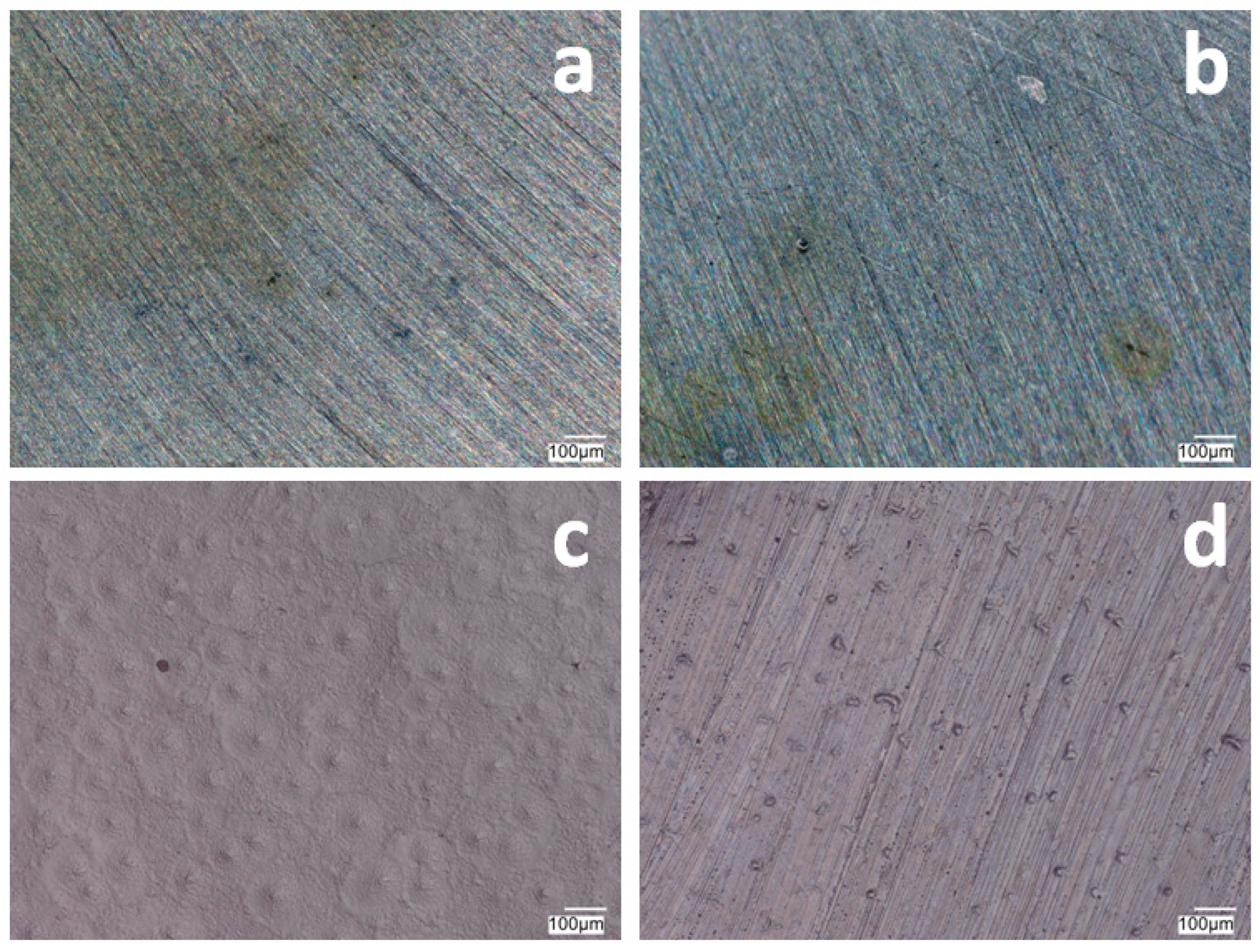
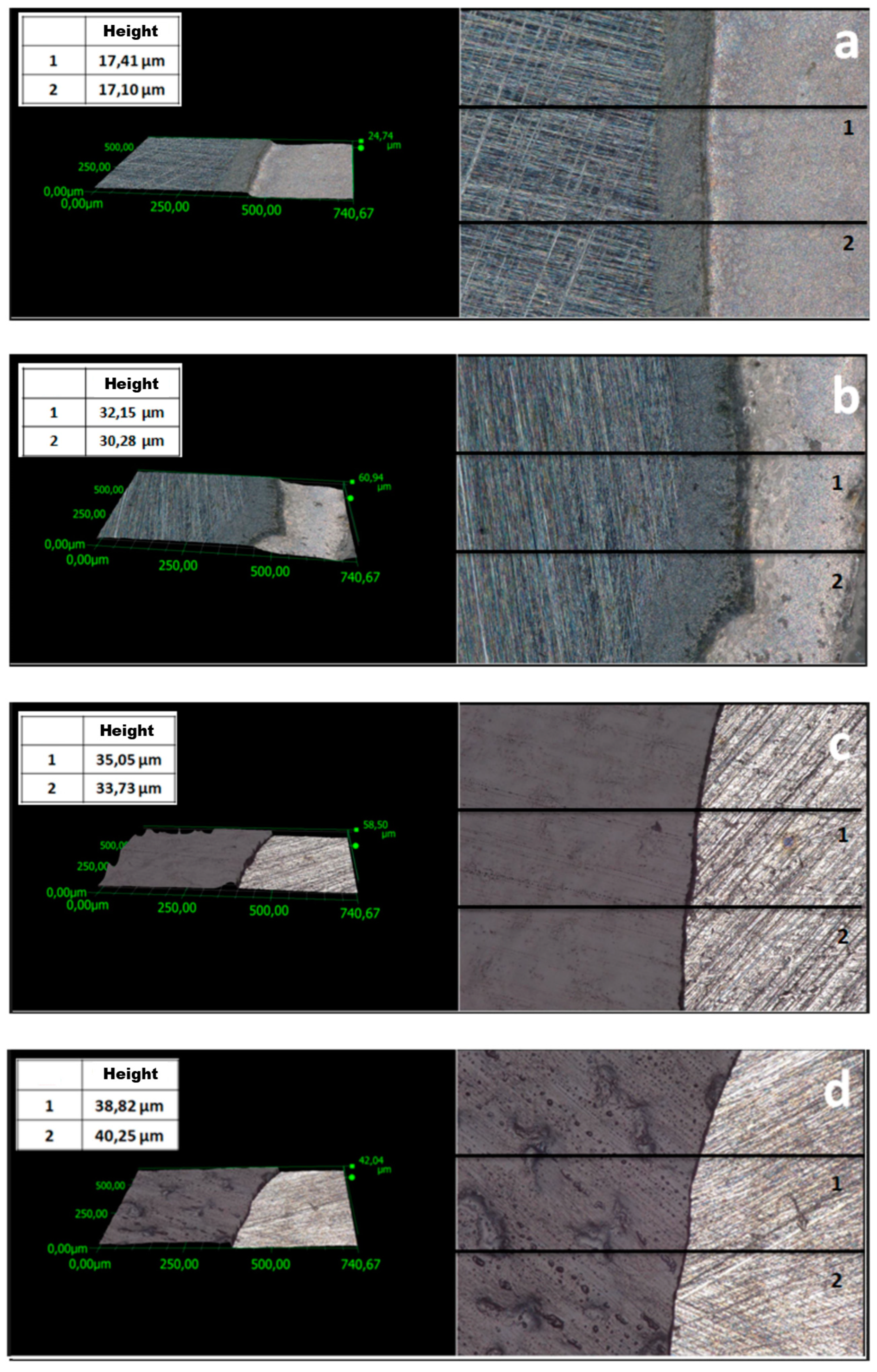
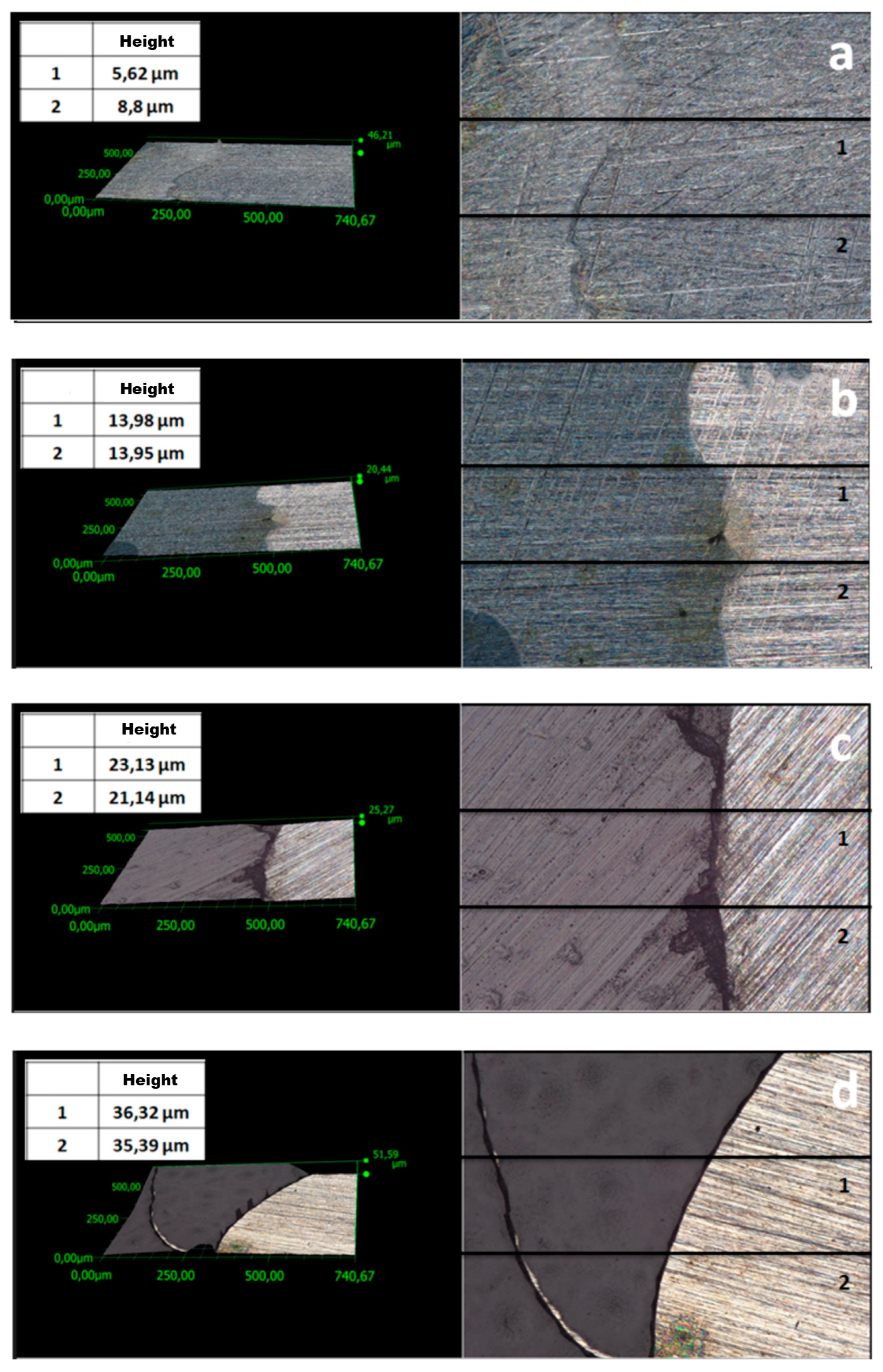
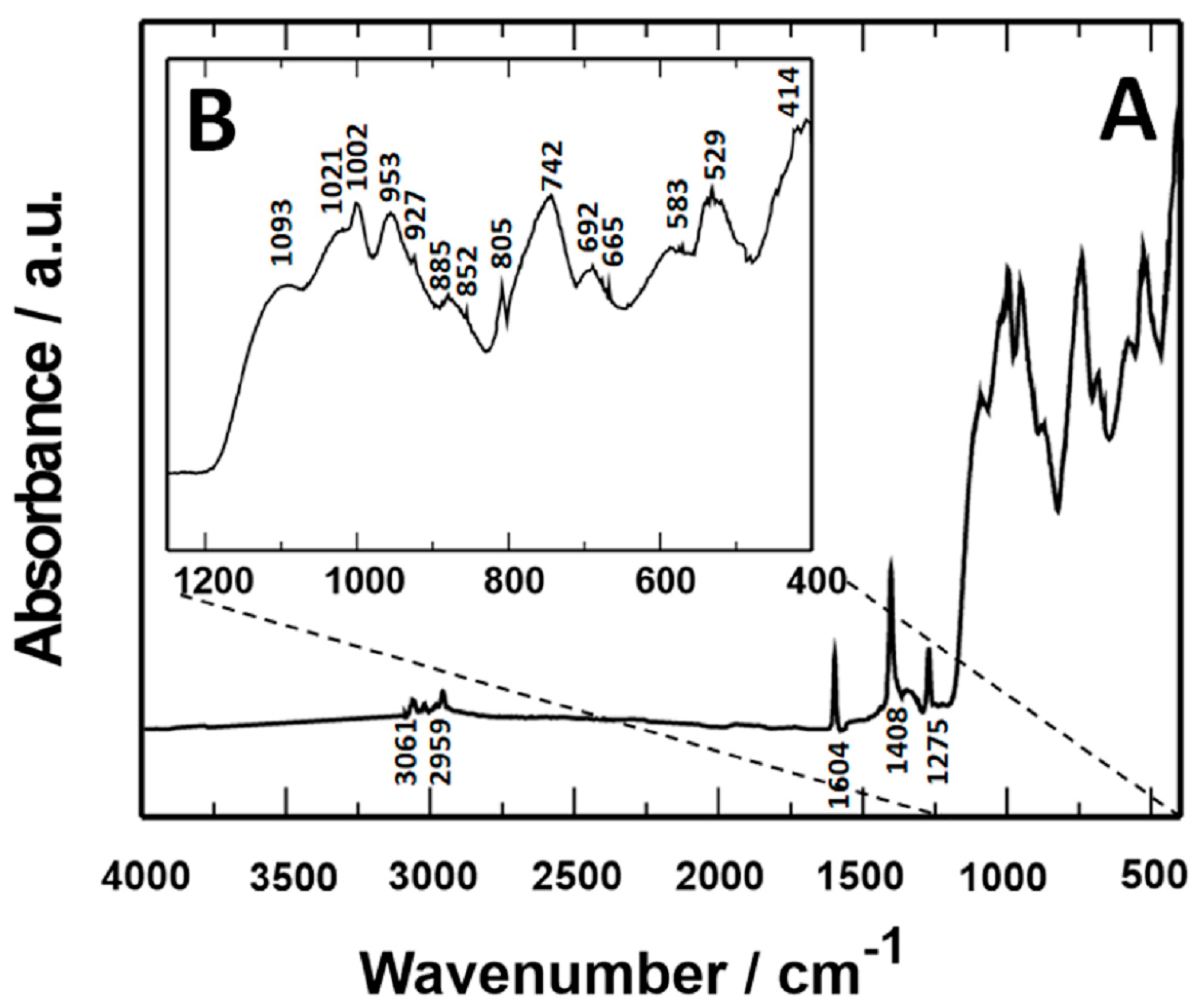
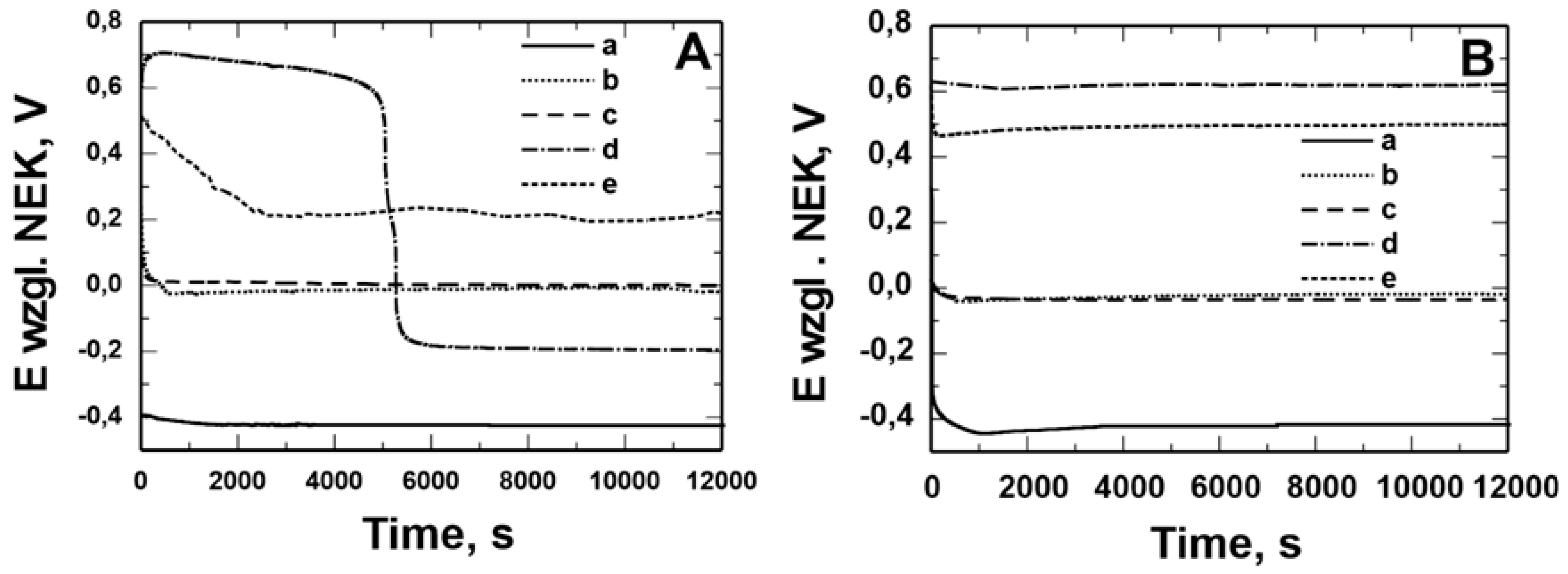
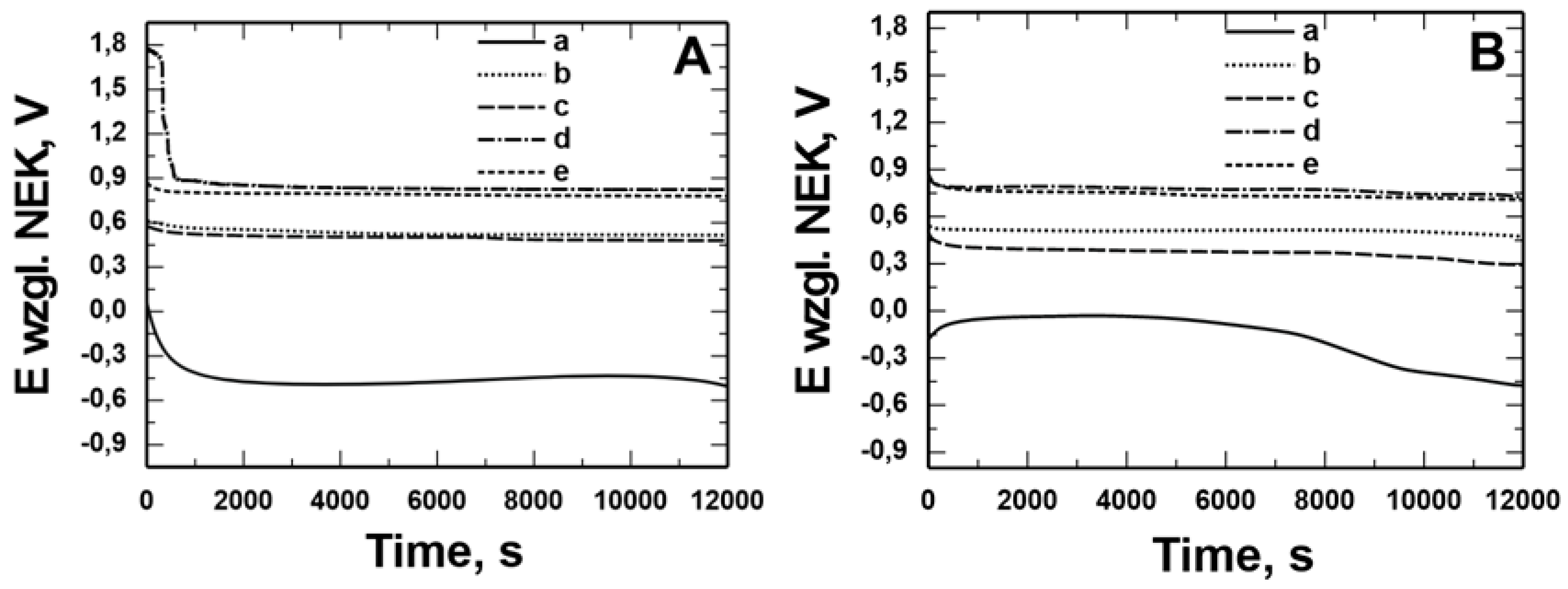
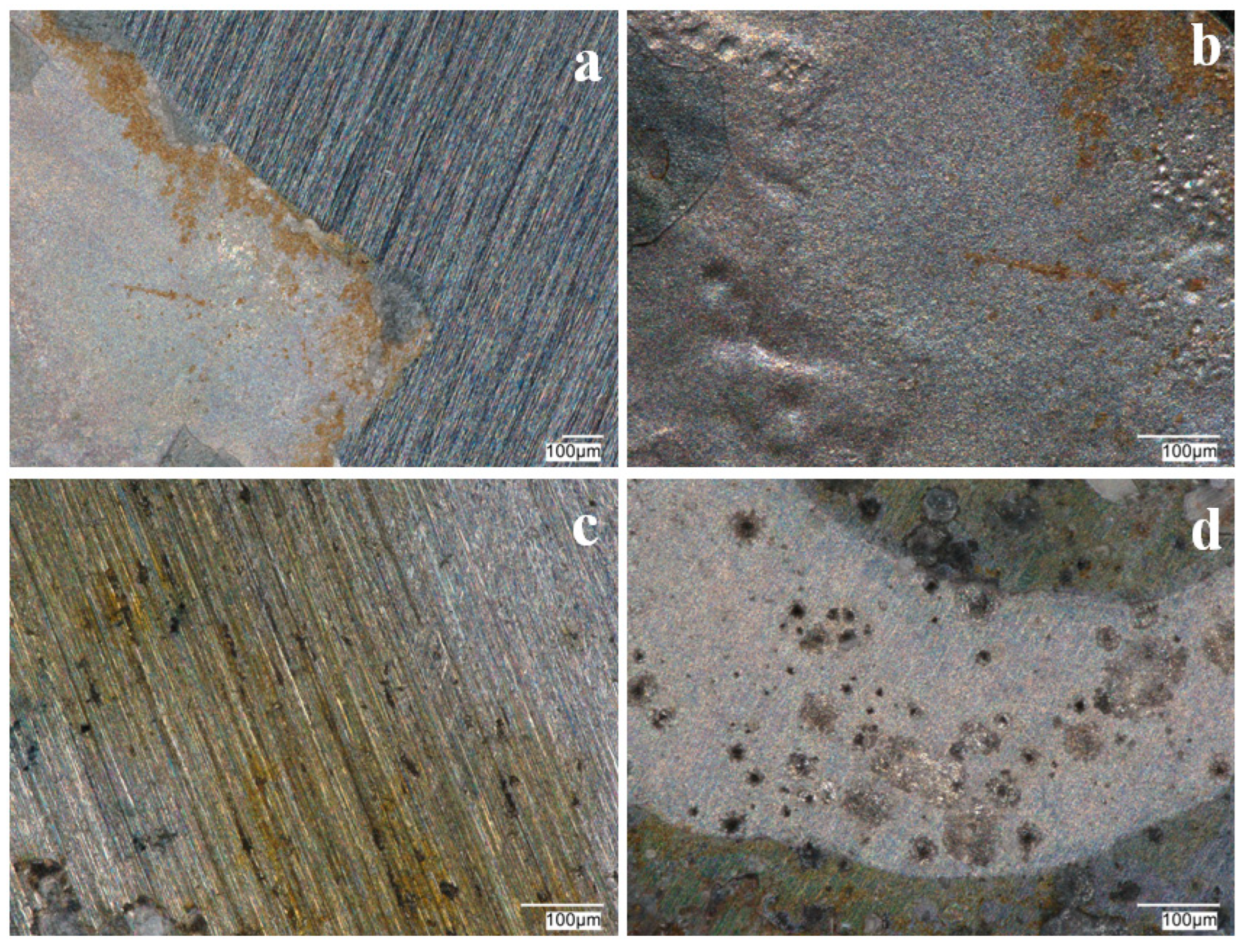



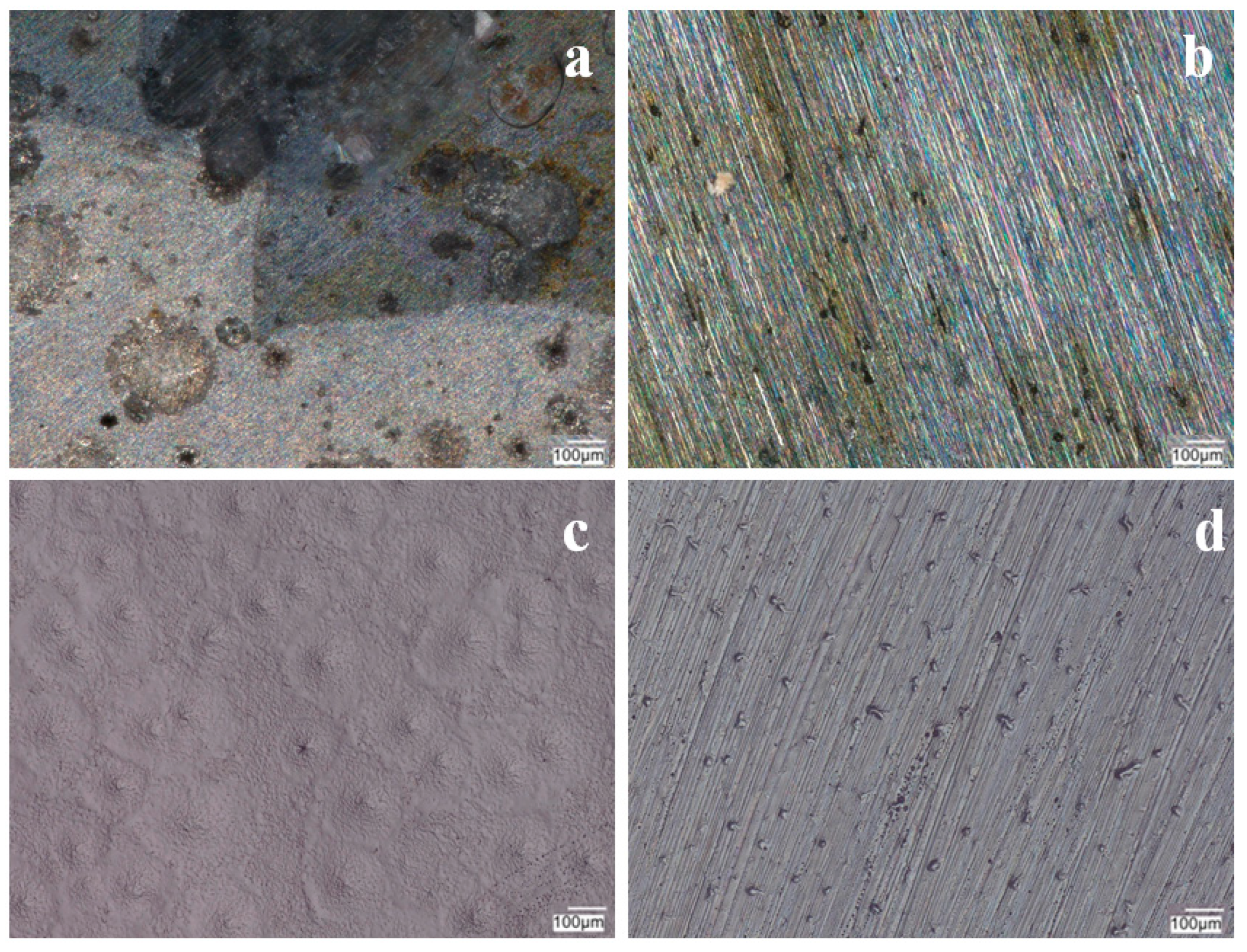
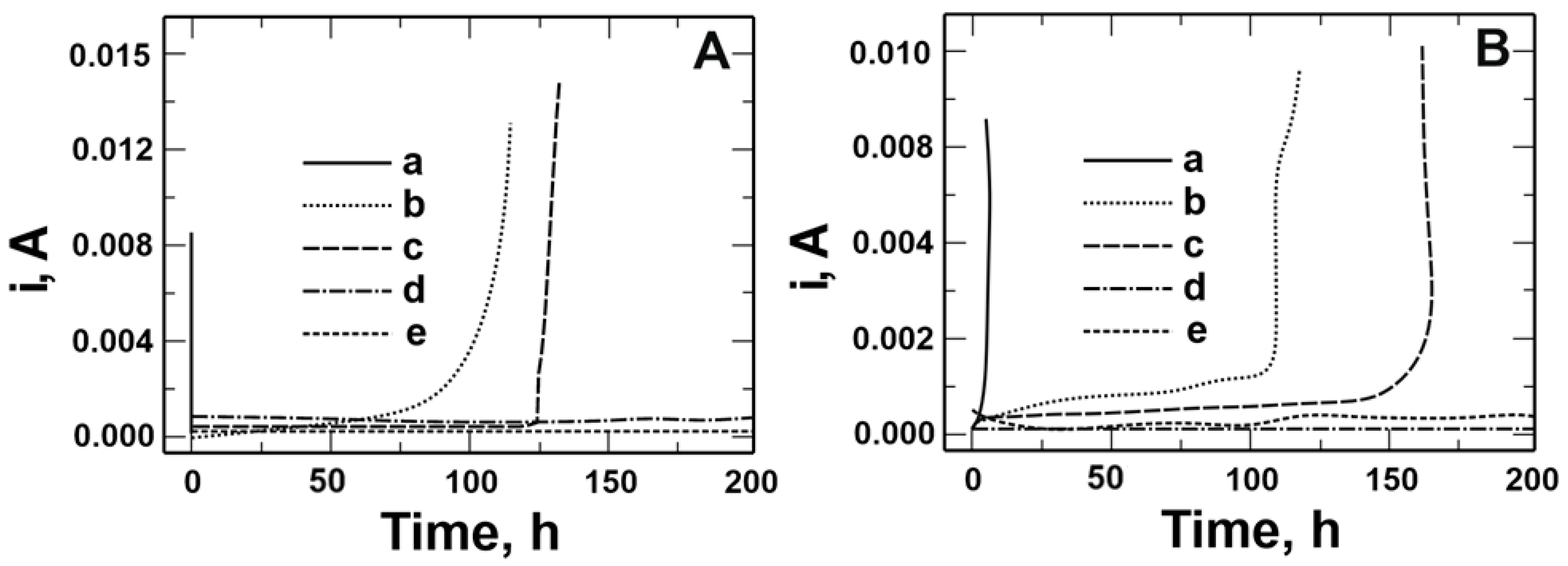
| C % | Cr% | Si% | Ni% | Mn% | V% | P% | S% | Ti% | Mo% | W% | |
|---|---|---|---|---|---|---|---|---|---|---|---|
| X20Cr13 | 0.17 | 12.6 | 0.34 | 0.25 | 0.30 | 0.04 | 0.024 | <0.005 | - | - | - |
| 41Cr4 | 0.36–0.45 | 0.80–1.20 | 0.17–0.37 | max 0.30 | 0.50–0.90 | max 0.05 | max 0.035 | max 0.035 | max 0.05 | max 0.10 | max 0.20 |
| Instruments | Mean Thickness of VTMS/PEDOT/PMo12 Coating with Different EDOT/PMo12 Powder Content | |||||||
|---|---|---|---|---|---|---|---|---|
| 0.1 g | 0.15 g | 0.25 g | 0.35 g | |||||
| Steel X20Cr13 | Steel 41Cr4 | Steel X20Cr13 | Steel 41Cr4 | Steel X20Cr13 | Steel 41Cr4 | Steel X20Cr13 | Steel 41Cr4 | |
| KEYENCE VHX-7000 microscope | 17.26 µm | 7.24 µm | 31.22 µm | 13.97 µm | 34.39 µm | 22.14 µm | 39.54 µm | 35.86 µm |
| Testan DT-20 AN 120 157 | 16.58 µm | 5.11 µm | 29.59 µm | 10.74 µm | 32.81 µm | 20.35 µm | 37.27 µm | 32.71 µm |
| Mean thickness (digital microscope and thickness gauge) | 16.92 µm | 6.16 µm | 30.41 µm | 12.36 µm | 33.6 µm | 21.25 µm | 38.39 µm | 34.29 µm |
| 2D Surface Roughness: Ra [µm] | ||
|---|---|---|
| VTMS/PEDOT/PMo12 coating | X20Cr13 steel | 41Cr4 steel |
| 0.1 g of EDOT/PMo12 powder | 3.66 | 1.83 |
| 0.15 g of EDOT/PMo12 powder | 3.9 | 5.62 |
| 0.25 g of EDOT/PMo12 powder | 5.24 | 6.97 |
| 0.35 g of EDOT/PMo12 powder | 6.88 | 8.5 |
| Corrosion Solution | X20Cr13 Steel | 41Cr4 Steel | ||
|---|---|---|---|---|
| EDOT/PMo12 [g] | Potential [V] | EDOT/PMo12 [g] | Potential [V] | |
| general corrosion 0.5 mol dm−3 Na2SO4 ph = 2 | 0.1 | ca. −0.15 V | 0.1 | ca. 0.6 V |
| 0.15 | ca. 0.0 V | 0.15 | ca. 0.57 V | |
| 0.25 | initially at 0.7 V, rapidly decreasing to −0.2 V after 5500 s | 0.25 | falls sharply to 0.9 V for the first 1000 s and remains at this level for a further 11,000 s | |
| 0.35 | for about 2500 s decreases from 0.5 V to 0.2 V and remains at 0.2 V for another 9500 s | 0.35 | ca. 0.85 V | |
| pitting corrosion 0.5 mol dm−3 Na2SO4 + 0.5 mol dm−3 NaCl pH = 2 | 0.1 | ca. −0.1 V | 0.1 | 0.55 V |
| 0.15 | ca. −0.08 V | 0.15 | 0.5 V to 0.3 V | |
| 0.25 | ca. 0.6 V | 0.25 | ca. 0.87 V | |
| 0.35 | ca. 0.5 V | 0.35 | ca 0.87 V | |
| Steel X20Cr13 VTMS/PEDOT/PMo12 | Potential Corrosive E [V] | Current Density Corrosive i [mAcm−2] | Polarization Resistance tgα [Ω*cm2] | |||
|---|---|---|---|---|---|---|
| General Corrosion | Pitting Corrosion | General Corrosion | Pitting Corrosion | General Corrosion | Pitting Corrosion | |
| 0.1 g | −0.313 | −0.319 | 8.08 × 10−5 | 9.765 × 10−5 | 0.50168 | 0.66663 |
| 0.15 g | −0.220 | −0.219 | 6.705 × 10−5 | 4.8155 × 10−4 | 1.05892 | 0.26357 |
| 0.25 g | 0.398 | 0.415 | 9.115 × 10−8 | 9.725 × 10−5 | 36.55406 | 61.10981 |
| 0.35 g | 0.242 | 0.244 | 6.78 × 10−6 | 9.825 × 10−5 | 43.72182 | 85.44327 |
Disclaimer/Publisher’s Note: The statements, opinions and data contained in all publications are solely those of the individual author(s) and contributor(s) and not of MDPI and/or the editor(s). MDPI and/or the editor(s) disclaim responsibility for any injury to people or property resulting from any ideas, methods, instructions or products referred to in the content. |
© 2024 by the authors. Licensee MDPI, Basel, Switzerland. This article is an open access article distributed under the terms and conditions of the Creative Commons Attribution (CC BY) license (https://creativecommons.org/licenses/by/4.0/).
Share and Cite
Kucharczyk-Kotlewska, A.; Adamczyk, L.; Miecznikowski, K.; Dudek, A. Protective Properties of Silane Composite Coatings Modified with Poly(3,4-ethylenedioxythiophene) with Heteropolyacid on X20Cr13 and 41Cr4 Steel. Materials 2024, 17, 6177. https://doi.org/10.3390/ma17246177
Kucharczyk-Kotlewska A, Adamczyk L, Miecznikowski K, Dudek A. Protective Properties of Silane Composite Coatings Modified with Poly(3,4-ethylenedioxythiophene) with Heteropolyacid on X20Cr13 and 41Cr4 Steel. Materials. 2024; 17(24):6177. https://doi.org/10.3390/ma17246177
Chicago/Turabian StyleKucharczyk-Kotlewska, Aleksandra, Lidia Adamczyk, Krzysztof Miecznikowski, and Agata Dudek. 2024. "Protective Properties of Silane Composite Coatings Modified with Poly(3,4-ethylenedioxythiophene) with Heteropolyacid on X20Cr13 and 41Cr4 Steel" Materials 17, no. 24: 6177. https://doi.org/10.3390/ma17246177
APA StyleKucharczyk-Kotlewska, A., Adamczyk, L., Miecznikowski, K., & Dudek, A. (2024). Protective Properties of Silane Composite Coatings Modified with Poly(3,4-ethylenedioxythiophene) with Heteropolyacid on X20Cr13 and 41Cr4 Steel. Materials, 17(24), 6177. https://doi.org/10.3390/ma17246177






